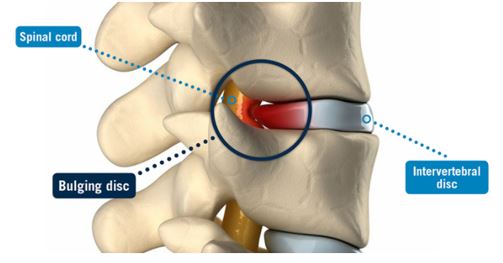We Are Bulging Disc Experts
state of the art ultrasonic Bulging Disc Treatment
What is Bulging Disc ?
If you have been diagnosed with a bulging disc, you are not alone. Bulging discs, also known as a disc protrusion, are a very common occurrence. They usually remain asymptomatic; however, they can cause discomfort and disability in various parts of the body if the disc compresses an adjacent nerve root or the spinal cord. As we age, the outer fibrous portion of our discs can weaken. Pressure from the central core of the disc can then stretch to the outer rim, causing the disc to bulge. If left untreated, the disc can continue to bulge until it tears, which is classified as a herniated disc.
Because a bulging disc does not always show symptoms, many people have bulging discs without realizing it. As long as the bulging area does not press against a nearby nerve, no symptoms occur. When the bulging disc does cause a pinched nerve, however, you may begin to experience symptoms. In the lower back, the damaged disc can cause pain to travel to the hips, buttocks, legs and feet. In the cervical spine, pain can radiate from the neck, down the arm and to the fingers.
Approximately 90 percent of bulging discs occur in the lower back, or lumbar area, of the spine. The most common lumbar bulging disc is seen between lumbar vertebrae L4 and L5, and between vertebrae L5 and S1, causing pain in the L5 nerve or S1 spinal nerve, respectively. The sciatic nerve receives neurons from spinal nerves L3 through S3. If the bulging disc impinges upon one or more of these six spinal nerves, then sciatic pain could result. Sciatic pain originates in the low back, radiates through the buttocks, down the back to the leg and could extend all the way to the foot.

What Are The Causes Of Bulging Disc?
Understanding the cause of bulging disc can help you avoid painful symptoms arising from them. Bulging discs occur with weakening of the outer fibrous containment ring of the disc. This weakening is often age related and thus unavoidable. However, some activities speed up the development of disc bulges and are to be avoided. Protect your back when lifting, use good posture, maintain a healthy weight and exercise regularly to strengthen core muscles supporting body weight.
Following the diagnosis of a symptomatic bulging disc, your physician will recommend treatments designed to relieve symptoms, such as rest, warm compresses, exercises and medication. Most of the time, symptoms arising from a bulging disc will abate with this conservative treatment. If conservative treatment fails, your physician might recommend surgery.
Am I the right patient for Bulging Disc Treatment?
If you have bulging disc, call us about the SonoSpine Procedure